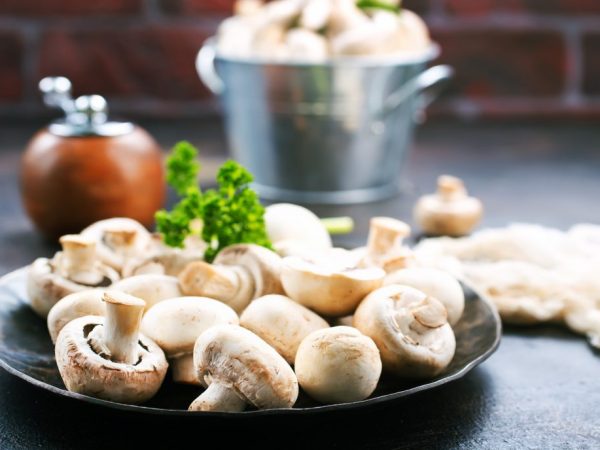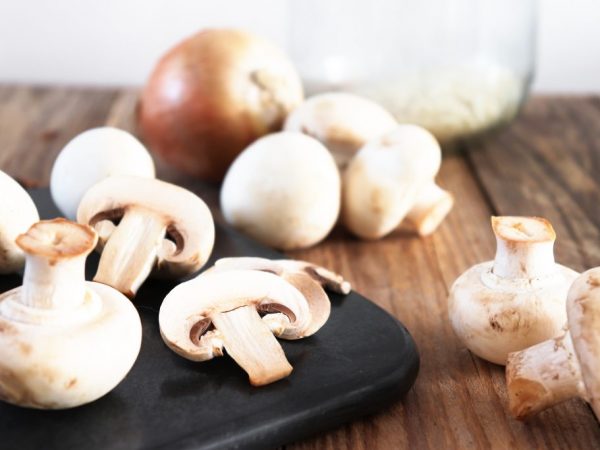The benefits and harms of champignons when breastfeeding
There are many rules and restrictions in the nutrition of nursing mothers - they are all fair and did not arise from scratch. Mushrooms are healthy and nutritious, but they are too hard to digest, therefore they are prohibited during the lactation period, but there are exceptions to the rule. Mushrooms such as champignons can be consumed in small quantities when breastfeeding.

The benefits and harms of champignons when breastfeeding
Contraindications
There are many contraindications regarding the use of champignons during the lactation period. A nursing mother can start using champignons only with the approval of a doctor and no earlier than 3 months after giving birth. During 3 months of life, the baby's digestive system is formed, which is able to perceive heavier elements in breast milk. Mushroom dishes are contraindicated in fried and pickled form.
You can not eat mushrooms in the following cases:
- mom: upset gastrointestinal tract, constipation, kidney problems, gallbladder;
- child:
- deviations in the development of the gastrointestinal tract, liver, kidneys, cardiac system;
- infant diathesis;
- negative reaction from the gastrointestinal tract to meat, dairy products.
Beneficial features
Champignons are especially popular among the population of the country. They have long been cultivated and grown on an industrial scale, which makes it possible to buy quality products without fear of being poisoned by poisonous twins. They are easier to digest than their forest counterparts. The assimilation of fungi by the body is 80-90%.
Beneficial features:
- high water content allows you to maintain acid-water balance, improve metabolism;
- the fiber content allows you to permanently remove the feeling of hunger and provide the body with the necessary amount of carbohydrates to maintain tone;
- the proteins contained in mushrooms help to quickly remove toxins from the body, are actively involved in metabolic processes, the construction and regeneration of cells;
- antioxidants help to increase immunity, which is especially important in the case of nursing mothers;
- minerals are iron, calcium, phosphorus, iodine and zinc.
Champignon will easily become a worthy substitute for meat products. It has a low calorie content: 100 g contains only 27 kcal. Champignons are the safest mushrooms sold in stores. No chemical additives are used for their cultivation. Mushrooms are grown on thermally treated substrates of straw and compost.
Problems with the use of the product
Mushroom bodies contain not only vitamins and trace elements, but also fiber, similar in composition to chitin, which is difficult to assimilate and takes a long time to digest. Children are forbidden to give mushrooms up to 7-8 years, so as not to provoke a "stop" of the stomach. If we are talking about breastfeeding, then the carbohydrate is absorbed first in the female body, and already in a modified (more accessible) form enters milk.
The second problem is the risk of poisoning. If mom comes across a poisonous mushroom, the child will also be poisoned.The poison will have a stronger effect on his body, so mothers need to carefully monitor the food they consume and buy it only in the store. If you buy champignons on the market, you must have a trusted supplier (seller) of this product. Otherwise, such purchases are fraught with negative consequences. It is worth remembering that mushrooms have the ability to accumulate toxins as they age. Darkened champignons are not edible.
The use of mushroom products in the diet

Mushrooms need to be chewed well
The use of champignons with HS complicates the presence of chitin, which makes it difficult to digest. This component performs supporting functions in the body of the fungus, which allows it to participate in the construction of protective membranes of the cell. Chitin is closely related to protein, making it difficult to digest during the postpartum period. In order for the amino acids derived from protein to work properly, the product must be thoroughly chewed or grinded.
Drying is an alternative method. It is better to use only hats. They need to be dried in the sun and ground into powder using a coffee grinder or spice grinder. Then it is used to make soups and various sauces.
Dr. Komarovsky advises not to deny yourself mushroom dishes, but consume them in moderation while breastfeeding. In 1-2 months after the birth of a baby, such products are strictly prohibited. The mother needs to restore balance and balance the diet by examining the baby's response to the product. At 1 week of a baby's life, vegetable soups, low-fat dairy products, lingering cookies are acceptable. From the first month, meat broths are gradually introduced.
Mushroom dishes in the form of soup or sauce are gradually introduced at 3 months of the baby's life. The first time mushroom products are consumed in the morning (no more than 100 g). It is necessary to observe the baby's reaction to new products for 24-48 hours from the moment of consumption by the mother.
Irina Selyutina (Biologist):
It is unambiguous to say whether it is possible or not for a young mother to eat champignons while breastfeeding a child. Give it a try and see how your baby responds: if everything is okay, keep adding mushrooms to your diet a little at a time. If you notice a response from the child, it is better to stop eating mushrooms and be patient until the end of the lactation period. During the period of breastfeeding, a woman is shown light food. Fat and acid from pickled or fried mushrooms will not make a child healthier. But you can cook champignons with apples:
- 500 g of champignons;
- 4-5 apples (not very sweet),
- 0.5 cups mushroom broth (not salted);
- salt to taste.
Rinse the champignons well, chop finely and send to a saucepan. Pour in some water and simmer over the fire for 20 minutes. While the mushrooms are cooking, wash the apples, cut into wedges and add to the mushrooms. Salt, mix, pour over mushroom broth. Simmer for 10 minutes. Enjoy your meal!
When a child develops certain reactions, it is important to immediately stop eating mushrooms and consult a doctor.
Symptoms:
- bloating (flatulence);
- vomiting;
- refusal of milk;
- changes in stool color;
- restlessness.
Selection of quality products
The main task of a nursing mother is to choose the right product. The cap of the edible young champignon is colored white or slightly pinkish. If the hats are dark, you should refuse to buy: the product has been on the counter for too long or was collected overripe.
In high-quality fruit bodies, the structure is dense, in specimens that are soft to the touch, the process of decay has already begun, they are dangerous to human health. The pulp of a ripe champignon exudes a pleasant mushroom aroma. If sour notes are caught, the time for picking the mushrooms was chosen incorrectly or they were stored in the store without observing sanitary standards.
For your information. When buying a product in a store, keep in mind that the ideal product will not be by weight, but packaged in containers.
Conclusion
Mushroom dishes in the diet of nursing mothers will not harm the health of the baby if the parents follow all the rules of use. They can be introduced only from 3 months of a baby's life, not earlier. After the first consumption of mushroom dishes, you need to wait a while to see the reaction of the crumbs to the new product. If, after 48 hours, negative reactions are not observed, the mushroom products are consumed again.



